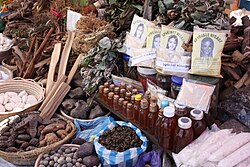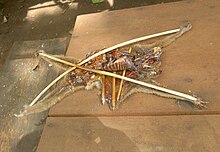Traditional medicine

| This article is part of a series on |
| Alternative medicine |
|---|
 |
Traditional medicine (also known as indigenous medicine or folk medicine) comprises medical aspects of traditional knowledge that developed over generations within the folk beliefs of various societies, including indigenous peoples, before the era of modern medicine. The World Health Organization (WHO) defines traditional medicine as "the sum total of the knowledge, skills, and practices based on the theories, beliefs, and experiences indigenous to different cultures, whether explicable or not, used in the maintenance of health as well as in the prevention, diagnosis, improvement and treatment of physical and mental illness".[1] Traditional medicine is often contrasted with scientific medicine.
In some
.The WHO notes, however, that "inappropriate use of traditional medicines or practices can have negative or dangerous effects" and that "further research is needed to ascertain the efficacy and safety" of such practices and medicinal plants used by traditional medicine systems.[1] Its "Traditional Medicine Strategy 2014–2023" said that the WHO would "support Member States in developing proactive policies and implementing action plans that will strengthen the role traditional medicine plays in keeping populations healthy."[2]
Usage and history
Classical history
In the written record, the study of herbs dates back 5,000 years to the ancient
Many herbs and minerals used in
Roman sources included
Some fossils have been used in traditional medicine since antiquity.[7]
Medieval and later
Arabic indigenous medicine developed from the conflict between the magic-based medicine of the
Translations of the early Roman-Greek compilations were made into German by Hieronymus Bock whose herbal, published in 1546, was called Kreuter Buch. The book was translated into Dutch as Pemptades by Rembert Dodoens (1517–1585), and from Dutch into English by Carolus Clusius, (1526–1609), published by Henry Lyte in 1578 as A Nievve Herball. This became John Gerard's (1545–1612) Herball or General Historie of Plantes.[5][6] Each new work was a compilation of existing texts with new additions.
Women's folk knowledge existed in undocumented parallel with these texts.
Martín de la Cruz wrote a herbal in
Colonial America
In 17th and 18th-century America, traditional folk healers, frequently women, used herbal remedies,
Modern usage
The prevalence of folk medicine in certain areas of the world varies according to cultural norms.[23] Some modern medicine is based on plant phytochemicals that had been used in folk medicine.[24] Researchers state that many of the alternative treatments are "statistically indistinguishable from placebo treatments".[25]
Knowledge transmission and creation
Indigenous medicine is generally transmitted orally through a community, family and individuals until "collected". Within a given culture, elements of indigenous medicine knowledge may be diffusely known by many, or may be gathered and applied by those in a specific role of healer such as a shaman or midwife.[26] Three factors legitimize the role of the healer – their own beliefs, the success of their actions and the beliefs of the community.[27] When the claims of indigenous medicine become rejected by a culture, generally three types of adherents still use it – those born and socialized in it who become permanent believers, temporary believers who turn to it in crisis times, and those who only believe in specific aspects, not in all of it.[28][verification needed]
Definition and terminology
Traditional medicine may sometimes be considered as distinct from folk medicine, and considered to include formalized aspects of folk medicine. Under this definition folk medicine are longstanding remedies and practises passed on and practiced by lay people. Folk medicine consists of the healing modalities, ideas of body physiology and health preservation known to some in a culture, transmitted informally as general knowledge, and practiced or applied by anyone in the culture having prior experience.[29]
Folk medicine
Many countries have practices described as folk medicine which may coexist with formalized, science-based, and institutionalized systems of medical practice represented by conventional
Australian bush medicine
Generally, bush medicine used by
Native American medicine
Nattuvaidyam
Nattuvaidyam was a set of indigenous medical practices that existed in India before the advent of allopathic or western medicine.[37] These practices had different sets of principles and ideas of the body, health and disease. There were overlaps and borrowing of ideas, medicinal compounds used and techniques within these practices.[38] Some of these practices had written texts in vernacular languages like Malayalam, Tamil, Telugu, etc. while others were handed down orally through various mnemonic devices. Ayurveda was one kind of nattuvaidyam practised in south India.[39] The others were kalarichikitsa (related to bone setting and musculature),[40] marmachikitsa (vital spot massaging), ottamoolivaidyam (single dose medicine or single time medication),[41] chintamanivaidyam and so on. When the medical system was revamped in twentieth century India, many of the practices and techniques specific to some of these diverse nattuvaidyam were included in Ayurveda.[42]
Home remedies
A home remedy (sometimes also referred to as a granny cure) is a treatment to cure a
One of the more popular examples of a home remedy is the use of
Criticism
Safety concerns
Although 130 countries have regulations on folk medicines, there are risks associated with the use of them (i.e. zoonosis, mainly as some traditional medicines still use animal-based substances[47][48]). It is often assumed that because supposed medicines are natural that they are safe, but numerous precautions are associated with using herbal remedies.[49]
Use of endangered species

Endangered animals, such as the slow loris, are sometimes killed to make traditional medicines.[50]
Shark fins have also been used in traditional medicine, and although their effectiveness has not been proven, it is hurting shark populations and their ecosystem.[51]
The illegal ivory trade can partially be traced back to buyers of traditional Chinese medicine. Demand for ivory is a huge factor in the poaching of endangered species such as rhinos and elephants.[52]
See also
- Ayurveda
- Bioprospecting
- Folk healer
- Herbal medicine
- Jarrah (surgeon)
- Medicinal plants
- Native American ethnobotany
- Old wives' tale
- Pharmacognosy
- Traditional African medicine
- Traditional Chinese medicine
- Traditional Knowledge Digital Library
- List of forms of alternative medicine
References
- ^ a b "Traditional Medicine: Definitions". World Health Organization. 2008-12-01. Retrieved 2014-04-20.
- ^ "WHO traditional medicine strategy: 2014-2023". The World Health Organization. December 2013. Archived from the original on January 13, 2014.
- ^ "Ebers' Papyrus". Retrieved 28 December 2014.
- ^ Girish Dwivedi, Shridhar Dwivedi (2007). History of Medicine: Sushruta – the Clinician – Teacher par Excellence (PDF). National Informatics Centre. Archived from the original (PDF) on 2008-10-10. Retrieved 2008-10-08.
- ^ ISBN 978-0-8165-1646-9.
- ^ ISBN 978-0-7112-0914-5.
- ^ van der Geer, Alexandra; Dermitzakis, Michael (2010). "Fossils in pharmacy: from "snake eggs" to "Saint's bones"; an overview" (PDF). Hellenic Journal of Geosciences. 45: 323–332.
- ISBN 978-0-7103-0203-8.
- ISBN 978-84-00-07727-3.
- ISBN 978-0-415-02063-3.
- ^ Diane Boulanger (2002), "The Islamic Contribution to Science, Mathematics and Technology", OISE Papers, in STSE Education, Vol. 3.
- ^ Tschanz David W (2003). "Arab Roots of European Medicine". Heart Views. 4: 2.
- PMID 12757434.
- S2CID 30959480.)
{{cite journal}}: CS1 maint: multiple names: authors list (link - ISBN 9789290222248. Archived from the original(PDF) on July 31, 2020. Retrieved 24 April 2020.
- PMID 1090996.
- ^ ISBN 978-0-415-92746-8.
- ^ Lozoya, Xavier (2016). "Libellus de Medicinalibus Indorum Herbis (Librito de las yerbas medicinales de los indios) o Códice Badiano". Arqueología Mexicana.
- ^ Rosalyn Fraad Baxandall, Linda Gordon, Susan Reverb, America's Working Women: A Documentary History, 1600 to the Present, W. W. Norton & Company, 1995, p. 50
- ^ Madsen, Deborah L. The Routledge Companion to Native American Literature, Routledge, 2015
- ^ Swerdlow JL. Medicine Changes: late 19th to early 20th century. Nature's Medicine: Plants that Heal. Washington, D.C.: National Geographic Society; 2000. pp. 158–91.
- ^ Eugenia M. Fulcher, Robert M. Fulcher, Cathy Dubeansky, Pharmacology: Principles and Applications'', Soto Elsevier Health Sciences, 2014, p. 5
- .
- ISSN 1394-3065
- ^ The Economist, "Alternative Medicine: Think yourself better", 21 May 2011, pp. 83–84.
- ISBN 978-81-7910-252-7.
- ^ Maurice Mwu, Eric Gbodossou (December 2000). "ALTERNATIVE MEDICINE: NIGERIA The role of traditional medicine" (PDF). The Lancet.
- ISBN 978-0-89789-113-4.
- ISBN 978-81-7910-252-7. pp 440.
- ^ "Traditional, complementary and integrative medicine". World Health Organization. 2018. Archived from the original on October 14, 2017. Retrieved 7 May 2018.
- ^ "WHO Traditional Medicine Strategy 2014-2023" (PDF). World Health Organization. 2013. Retrieved 7 May 2018.
- ^ "Traditional Aboriginal Bush Medicine". Aboriginal Art Online. Archived from the original on 25 May 2013. Retrieved 26 June 2013.
- ^ "Select Your Library - Credo Reference". search.credoreference.com. Retrieved 2015-04-17.
- ^ S2CID 145332334.
- ^ OCLC 1086616314.)
{{cite book}}: CS1 maint: location missing publisher (link - ^ S2CID 239650509.
- hdl:10603/148255. Retrieved 7 April 2021.
- ISBN 9780791478165.
- ^ K P, Girija (2016). "Refiguring of Ayurveda as Classical Tradition". Pragmata: Journal of Human Sciences. 3: 43–62.
- ^ TNN (22 Jul 2019). "Those availing kalari marma chikitsa on the rise". The Times of India. Retrieved 9 April 2021.
- ^ Correspondent (5 June 2016). "Ottamooli (single ingredient) cure for lifestyle diseases..." Onmanorama. Retrieved 9 April 2021.
- ISBN 9780367273002.
- ^ "Placebo Effect: A Cure in the Mind". Scientific American. February–March 2009.
- Catherine Esther Beecher Mrs. Beecher's Housekeeper and Healthkeeper1874. Retrieved on 2007-11-05.
- PMID 26044054.
- ^ Prince Wen Hui's Cook Bob Flaws and Honora Wolf 1985
- ^ Africa’s growing risk of diseases that spread from animals to people
- PMID 12801499.
- ^ "National Policy on Traditional Medicine and Regulation of Herbal Medicines - Report of a WHO Global Survey". World Health Organization. April 2016. Archived from the original on May 24, 2009.
- .
- ^ "Traditional medicines continue to thrive globally". www.cnn.com. CNN. Retrieved 2016-04-25.
- ISSN 0006-3207.
External links
 Media related to traditional medicine at Wikimedia Commons
Media related to traditional medicine at Wikimedia Commons

